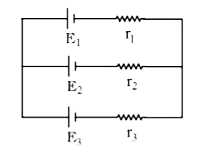There are three evens E1,E2and E3 one of which must, and only one can happen. The odds are 7 to 4 against E1 and 5 to 3 against E2. Find odds against E3.
The correct Answer is:65:23
To solve the problem, we need to find the odds against event E3 given the odds against events E1 and E2.
1. Understand the Odds Against Events:
- The odds against E1 are given as 7 to 4. This means for every 7 unfavorable outcomes, there are 4 favorable outcomes.
- The odds against E2 are given as 5 to 3. This means for every 5 unfavorable outcomes, there are 3 favorable outcomes.
2. Convert Odds to Probabilities:
- For E1:
Probability of E1=Favorable outcomesTotal outcomes=44+7=411
- For E2:
Probability of E2=33+5=38
3. Use the Property of Exhaustive Events:
- Since E1,E2, and E3 are mutually exclusive and exhaustive events, we know:
P(E1)+P(E2)+P(E3)=1
- Substituting the known probabilities:
411+38+P(E3)=1
4. Find a Common Denominator:
- The least common multiple of 11 and 8 is 88. We convert the fractions:
411=4×811×8=3288
38=3×118×11=3388
5. Substitute and Solve for P(E3):
- Now we can substitute these values into the equation:
3288+3388+P(E3)=1
6588+P(E3)=1
P(E3)=1−6588=88−6588=2388
6. Calculate Odds Against E3:
- The probability of E3 is 2388. The probability against E3 is:
P(not E3)=1−P(E3)=1−2388=6588
- The odds against E3 are given by the ratio of unfavorable outcomes to favorable outcomes:
Odds against E3=P(not E3)P(E3)=65882388=6523
Final Answer:
The odds against E3 are 65 to 23.
- The odds against E1 are given as 7 to 4. This means for every 7 unfavorable outcomes, there are 4 favorable outcomes.
- The odds against E2 are given as 5 to 3. This means for every 5 unfavorable outcomes, there are 3 favorable outcomes.
- For E1:
Probability of E1=Favorable outcomesTotal outcomes=44+7=411
- For E2:
Probability of E2=33+5=38
- Since E1,E2, and E3 are mutually exclusive and exhaustive events, we know:
P(E1)+P(E2)+P(E3)=1
- Substituting the known probabilities:
411+38+P(E3)=1
- The least common multiple of 11 and 8 is 88. We convert the fractions:
411=4×811×8=3288
38=3×118×11=3388
- Now we can substitute these values into the equation:
3288+3388+P(E3)=1
6588+P(E3)=1
P(E3)=1−6588=88−6588=2388
- The probability of E3 is 2388. The probability against E3 is:
P(not E3)=1−P(E3)=1−2388=6588
- The odds against E3 are given by the ratio of unfavorable outcomes to favorable outcomes:
Odds against E3=P(not E3)P(E3)=65882388=6523
The odds against E3 are 65 to 23.
Topper's Solved these Questions
- PROBABILITYBOOK - MODERN PUBLICATIONCHAPTER - PROBABILITYEXERCISE - EXERCISE 16 (a) SHORT ANSWER TYPE QUESTIONSSATQ
11 Videos
- PROBABILITYBOOK - MODERN PUBLICATIONCHAPTER - PROBABILITYEXERCISE - EXERCISE 16 (B) SHORT ANSWER TYPE QUESTIONSSATQ
10 Videos
- PROBABILITYBOOK - MODERN PUBLICATIONCHAPTER - PROBABILITYEXERCISE - CHAPTER TEST
12 Videos
- PERMUTATIONS AND COMBINATIONS BOOK - MODERN PUBLICATIONCHAPTER - PERMUTATIONS AND COMBINATIONS EXERCISE - CHAPTER TEST
12 Videos
- RELATIONS AND FUNCTIONSBOOK - MODERN PUBLICATIONCHAPTER - RELATIONS AND FUNCTIONSEXERCISE - Chapter Test
11 Videos
Similar Questions
There are three events A, B and C one of which must , and only one can happen, the odd are 7 to 3 against A and 5 to 9 for B. Find the odds, against C.
View SolutionThere are three events A, B and C one of which and only one can happen. The odds are 7 to 3 against A and 6 to 4 against B. The odds against C are
View Solution
Knowledge Check
There are three events A, B, C one of which must and only one can happen; The odds are 8 to 3 against A, 5 to 2 against B; find the odds against C.
A43:34B34:43C43:77D77:43Three batteries of emf E1,E2 and E3 and internal resistance r1,r2 and r3 are connected as shown. The current through the battery of emf E3 is zero if.
 AE1r2+E2r1=E3(r1+r2)BE1r2−E2r1=E3(r1+r2)CE1r2+E2r1=E3(r1+r2)DE1r1+E2r2=E3(r1+r2)
AE1r2+E2r1=E3(r1+r2)BE1r2−E2r1=E3(r1+r2)CE1r2+E2r1=E3(r1+r2)DE1r1+E2r2=E3(r1+r2)In the circuit shown here, E1=E2=E3=2V and R1=R2=4ohms. The current flowing between point A and B through battery E2 is
 AZeroB2amp from A to BC2amp from B to ADNone of the above
AZeroB2amp from A to BC2amp from B to ADNone of the above
There are three events A, B, C one of which must and only one can happen; The odds are 8 to 3 against A, 5 to 2 against B; find the odds against C.
View SolutionThere are three events A,B,C one of which must, and only one can, happen, the odds are 8 to 3 against A, 5 to 2 against B: Find the odds against C.
View SolutionThere are three events A, B and C, one of which must, and only one can happen. The odds against the event A are7:4 and odds against event B are 5:3. Find the odds against event C.
View SolutionOf the three independent event E1,E2 and E3, the probability that only E1 occurs is α, only E2 occurs is β and only E3 occurs is γ. If the probavvility p that none of events E1,E2 or E3 occurs satisfy the equations (α−2β)p=αβ and (β−3γ)p=2βγ. All the given probabilities are assumed to lie in the interval (0, 1). Then, probability of occurrence of E1probability of occurrence of E3 is equal to
View SolutionA ship is fitted with three engines E1,E2,andE3 the engines function independently of each othe with respectively probability 1/2,1/4,and1/4. For the ship to be operational at least two of its engines must function. Let X denote the event that the ship is operational and let X1,X2,andX3 denote, respectively, the events that the engines E1,E2,andE3 are functioning. Which of the following is (are) true?
View Solution
